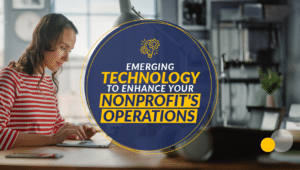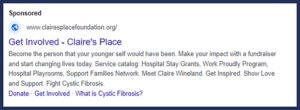 Emerging Technology To Enhance Your Nonprofit’s Operations
Emerging Technology To Enhance Your Nonprofit’s Operations
Today’s tech-driven world has ushered in a new era for nonprofits, offering a wealth of tools to engage donors and spread awareness.
Your nonprofit’s path forward hinges on understanding what technology is available and how you can use it to streamline operations, connect with supporters, and tap into current trends. Whether you’re looking to expand your reach or connect with corporate donors, this guide will prepare you to invest in the right technology to improve efficiency and amplify your impact.
Google Ad Grant
While the Google Ad Grant program has been available since 2003, its potential has never been greater. In today’s tech-driven landscape, nonprofits are adopting digital tools in increasingly creative and strategic ways. The Google Ad Grant program is no exception. It represents a cornerstone of this digital transformation, enabling nonprofits to amplify their reach like never before.
Through the program, your nonprofit can receive up to $10,000 in monthly ad credits to spend on Google Ads. So long as you have a secure and high-quality nonprofit website, these credits can be used to promote your site’s content on Google search results, boosting site traffic without the financial burden of paid advertising.
Here’s an example of a Google Ad for Claire’s Place Foundation, which organizes assistance for individuals and families affected by Cystic Fibrosis:
The Impact of Google Ads
Google is the world’s most popular search engine! Most of your existing and potential donors, volunteers, sponsors, and beneficiaries already use it daily, meaning you can dramatically expand your reach by advertising on it. Beyond that, this opportunity is also powerful due to:
- Advanced Targeting Capabilities: Google Ads offers sophisticated targeting options to reach specific demographics, geographic locations, and interest groups, ensuring your ads are seen by relevant audiences.
- Full Control Over Ad Campaigns: Nonprofits have complete control over their ads, allowing them to tailor their messaging, choose specific keywords, and promote their best landing pages. Strategically direct traffic to high-impact pages on your site, such as donation pages, volunteer opportunity sign-ups, upcoming event promotions, and informational content.
- Analytics and Reporting: Use the Google Ads dashboard and tools like Google Analytics to gain valuable insights into your audience. Understand which messages drive action, and see how visitors interact with your website. Use this data to optimize your campaigns, improve user experience, and make data-driven decisions that enhance your nonprofit’s impact.
Above all, you’ll improve your nonprofit’s visibility on Google’s search engine results pages, increasing the likelihood of attracting new supporters and beneficiaries actively searching for related causes. If eligible, apply for the Google grants program and start advertising your mission free of charge!
Generative Artificial Intelligence (AI)
With the release of ChatGPT in 2022, AI has become a regular topic of conversation. ChatGPT saw faster growth than TikTok and Instagram, acquiring 100 million users within its first two months. As a result, technology companies like Google and Microsoft quickly released their own AI tools.
Generative AI can aid your nonprofit’s content development and donor outreach. However, Getting Attention’s guide to SEO for nonprofits warns against using solely AI to write your content. Compared to human-written content, AI lacks originality and has been known to hallucinate information. Plus, Google penalizes content that it recognizes as written by AI.
Instead, try these strategies for using generative AI to support your content development:
- Suggest ideas for blog posts, social media updates, newsletters, and fundraising campaigns.
- Craft compelling blog post titles that improve click-through rates.
- Produce structured content outlines for your team to follow.
- Generate templates for personalized thank-you notes, donation appeals, and impact reports for donors.
- Craft email subject lines and calls to action to drive open rates and conversions.
- Proofread grant proposals and reports, ensuring all information is included, grammatically correct, and formatted properly.
By leveraging generative AI, your nonprofit can save time and create the content you need. There are plenty of other great uses for generative AI, so get creative!
Modern Fundraising Technology
Many nonprofits stop investing in new tools because their existing technology has successfully served their needs so far. If your fundraising is stuck, updated technology may be your answer to boosting donor engagement.
Here are some recent innovations in nonprofit fundraising technology to consider:
- Nonprofit eCard platforms empower organizations to create and distribute digital greeting cards for various occasions, such as holidays and birthdays. eCardWidget’s charity eCards guide explains that nonprofits can sell these eCards to donors, use them to show appreciation, or invite supporters to events. Some organizations boost awareness by allowing donors to send eCards to their friends and family for free.
- Fundraising auction software offers powerful features like mobile bidding, QR code check-in, customizable websites, and automated donor recognition. You can even host your fundraisers entirely online to eliminate geographical barriers to participation.
These examples highlight just a few of the many options available in fundraising technology. By exploring and investing in these innovative tools, your nonprofit can stay ahead of the curve and enhance your donor engagement and fundraising success.
Corporate Giving Technology
Employee giving is on the rise. Corporate giving research found that $5 billion is donated through workplace giving every year. What’s more, 39% of surveyed companies plan to expand their workplace giving programs within the next two years. This means more opportunities for employee matching gifts, payroll deductions, volunteerism, and more!
Nonprofit technology providers have developed new tools to support nonprofits in finding these opportunities. Some recent innovations include:
- Matching gift auto-submission. When employees donate to a nonprofit that uses matching gift software with auto-submission and their employer uses CSR software that integrates with matching gifts, the donor can allow the software to automatically submit their matching gift request to their employer. This dramatically simplifies the matching gift process, driving more matching gift requests to completion.
- Volunteer grant and volunteer time off (VTO) tools. Using a volunteer grant database, your nonprofit can easily research volunteers’ eligibility for programs like volunteer grants and VTO. Instead of scouring each company’s website, you or your volunteers can simply use the search tool to look up employers. The database will then provide detailed guidelines for participation, including minimum volunteer hour requirements, limits on grants and VTO per employee, and links to necessary forms.
Corporate giving is a reliable yet underused way to boost donations and volunteer hours. Make sure you have the technology in place to capitalize on as many corporate giving opportunities as possible.
Level Up Your Nonprofit’s Technology
With the right technology, your nonprofit can reach new heights in donor engagement and operational efficiency. To ensure you’re making the most of these opportunities, connect with a fundraising and technology consultant who can guide you in selecting and implementing the right solutions for your mission. Now, start investing in the right technology, amplifying your cause, and streamlining operations.
_______________
Guest Author
Jessica King, Business Lead at Getting Attention
 Jessica King is the business lead at Getting Attention, where she helps nonprofits acquire and manage the Google Ad Grant to expand their impact. Prior to her work at Getting Attention, Jessica worked in nonprofit and higher education organizations focusing on communication and digital marketing, and most recently in search engine optimization in the mission-driven sector.
Jessica King is the business lead at Getting Attention, where she helps nonprofits acquire and manage the Google Ad Grant to expand their impact. Prior to her work at Getting Attention, Jessica worked in nonprofit and higher education organizations focusing on communication and digital marketing, and most recently in search engine optimization in the mission-driven sector.
Jessica holds a master’s degree in communication from Virginia Tech. In her free time, you can find her reading, building furniture, and hanging out with her cats, Benny and Olive.
